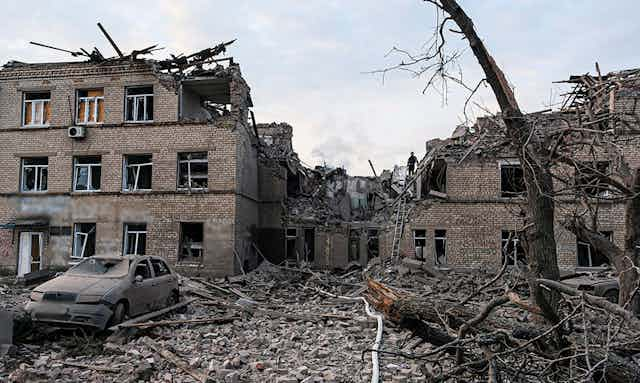Two years after its full-scale invasion of Ukraine, Russia is still facing an unprecedented number of economic sanctions. It has been excluded from major global financial services, and around €260 billion (£222 billion) of its central bank assets have been frozen.
Russian airspace is closed to most western planes, and western ports are closed to Russian vessels. A formal cap has been imposed on buying or processing Russian oil sold for more than US$60 per barrel (world prices currently fluctuate between $80 and $100. And in theory, it is illegal to sell Russia anything that could be used by the military.
Sanctions have had some effects. According to the IMF, Russia’s GDP is around 7% lower than the pre-war forecast.
Despite all of this, Russia’s economy has not collapsed. But it does look very different, and is now entirely focused on a long war in Ukraine – which is actually driving economic growth.
In fact, the IMF expects Russia to experience GDP growth of 2.6% this year. That’s significantly more than the UK (0.6%) and the EU (0.9%). Similarly, Russia’s budget deficit (the amount the government needs to borrow) is on track to remain below 1% of GDP, compared to 5.1% in the UK and 2.8% in the EU.
One reason for this relative resilience is Russia’s strong, independent central bank. Since 2022, it has imposed massive interest rate hikes (currently at 16%) to control inflation (still above 7%).
This has been combined with government-imposed controls which make it almost impossible for Russian exporters and the many foreign companies still operating in Russia to take money out of the country. Together, these policies have helped to avoid a total collapse of the ruble, by keeping the currency flowing inside Russia.
Russian firms have also learned to sidestep sanctions, with the oil cap being a prime example. In theory, no Russian oil should be traded with the west above the cap, which would have a massive impact on Russia’s public finances.
In practice, it has been circumvented by a large “dark” fleet of uninsured vessels and the use of accounting loopholes. And while sanctioning countries are trying to tighten the rules, Russia’s public coffers have actually been flooded with oil money.
Many countries have also made money playing the role of intermediaries. Turkey, China, Serbia, Bulgaria and India are among those which have reportedly circumvented sanctions, and carried on selling goods to Russia.
Those products are understood to often include dual-use goods such as microchips or communication equipment that are subsequently used by the Russian military. And despite recent efforts, a full regime of extra-territorial trade sanctions – which ban any foreign company from trading with Russia – is still far away.
Fortunes of war
But perhaps the most worrying reason for the Russian economy’s resilience is the war itself.
For a long time, the economy of Russia has not been diverse, relying heavily on the export of natural resources such as oil and gas. And a major reason for the relatively high revenue of the Russian government today is precisely that the war has led to high energy prices.
Russia’s public spending is at unprecedented levels, and around 40% of the government budget is spent on the war. Total military spending is expected to reach more than 10% of GDP for the year 2023 (the UK figure is 2.3%).

Military pay, ammunition, tanks, planes, and compensation for dead and wounded soldiers, all contribute to the GDP figures. Put simply, the war against Ukraine is now the main driver of Russia’s economic growth.
And it is a war that Russia cannot afford to win. The cost of rebuilding and maintaining security in a conquered Ukraine would be too great, and an isolated Russia could at best hope to become a junior partner entirely dependent on China.
In a context of collapsing infrastructure and growing social unrest inside Russia, the projected cost of rebuilding the occupied area is already massive.
A protracted stalemate might be the only solution for Russia to avoid total economic collapse. Having transformed the little industry it had to focus on the war effort, and with a labour shortage problem worsened by hundreds of thousands of war casualties and a massive brain drain, the country would struggle to find a new direction.
Thirty-five years after the fall of the Berlin wall, it has become clear that resource-rich Russia has become much poorer than its former Soviet neighbours such as Estonia, Latvia, Poland and Hungary, who pursued the route of European integration.
The Russian regime has no incentive to end the war and deal with that kind of economic reality. So it cannot afford to win the war, nor can it afford to lose it. Its economy is now entirely geared towards continuing a long and ever deadlier conflict.

